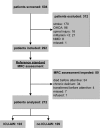Early prediction of intensive care unit-acquired weakness using easily available parameters: a prospective observational study
- PMID: 25347675
- PMCID: PMC4210178
- DOI: 10.1371/journal.pone.0111259
Early prediction of intensive care unit-acquired weakness using easily available parameters: a prospective observational study
Abstract
Introduction: An early diagnosis of Intensive Care Unit-acquired weakness (ICU-AW) using muscle strength assessment is not possible in most critically ill patients. We hypothesized that development of ICU-AW can be predicted reliably two days after ICU admission, using patient characteristics, early available clinical parameters, laboratory results and use of medication as parameters.
Methods: Newly admitted ICU patients mechanically ventilated ≥2 days were included in this prospective observational cohort study. Manual muscle strength was measured according to the Medical Research Council (MRC) scale, when patients were awake and attentive. ICU-AW was defined as an average MRC score <4. A prediction model was developed by selecting predictors from an a-priori defined set of candidate predictors, based on known risk factors. Discriminative performance of the prediction model was evaluated, validated internally and compared to the APACHE IV and SOFA score.
Results: Of 212 included patients, 103 developed ICU-AW. Highest lactate levels, treatment with any aminoglycoside in the first two days after admission and age were selected as predictors. The area under the receiver operating characteristic curve of the prediction model was 0.71 after internal validation. The new prediction model improved discrimination compared to the APACHE IV and the SOFA score.
Conclusion: The new early prediction model for ICU-AW using a set of 3 easily available parameters has fair discriminative performance. This model needs external validation.
Conflict of interest statement
Figures


Similar articles
-
Early Prediction of Intensive Care Unit-Acquired Weakness: A Multicenter External Validation Study.J Intensive Care Med. 2020 Jun;35(6):595-605. doi: 10.1177/0885066618771001. Epub 2018 May 1. J Intensive Care Med. 2020. PMID: 29716425 Free PMC article.
-
Predicting intensive care unit-acquired weakness in the first week of an intensive care unit stay: A multicentre external validation study.Aust Crit Care. 2025 Jul;38(4):101241. doi: 10.1016/j.aucc.2025.101241. Epub 2025 May 1. Aust Crit Care. 2025. PMID: 40311514
-
Acute reduction of erector spinae muscle cross-sectional area is associated with ICU-AW and worse prognosis in patients with mechanical ventilation in the ICU: A prospective observational study.Medicine (Baltimore). 2021 Nov 24;100(47):e27806. doi: 10.1097/MD.0000000000027806. Medicine (Baltimore). 2021. PMID: 34964749 Free PMC article.
-
Risk prediction models for intensive care unit-acquired weakness in critically ill patients: A systematic review.Aust Crit Care. 2025 Jan;38(1):101066. doi: 10.1016/j.aucc.2024.05.003. Epub 2024 Jul 15. Aust Crit Care. 2025. PMID: 39013706
-
Intensive care unit-acquired weakness: unanswered questions and targets for future research.F1000Res. 2019 Apr 17;8:F1000 Faculty Rev-508. doi: 10.12688/f1000research.17376.1. eCollection 2019. F1000Res. 2019. PMID: 31069055 Free PMC article. Review.
Cited by
-
Which factors are associated with acquired weakness in the ICU? An overview of systematic reviews and meta-analyses.J Intensive Care. 2024 Sep 5;12(1):33. doi: 10.1186/s40560-024-00744-0. J Intensive Care. 2024. PMID: 39232808 Free PMC article. Review.
-
Association of tissue oxygen saturation levels with skeletal muscle injury in the critically ill.Sci Rep. 2024 Feb 27;14(1):4811. doi: 10.1038/s41598-024-55118-1. Sci Rep. 2024. PMID: 38413660 Free PMC article.
-
Skeletal Muscle Index at Intensive Care Unit Admission Is a Predictor of Intensive Care Unit-Acquired Weakness in Patients With Sepsis.J Clin Med Res. 2019 Dec;11(12):834-841. doi: 10.14740/jocmr4027. Epub 2019 Nov 24. J Clin Med Res. 2019. PMID: 31803328 Free PMC article.
-
Early Prediction of Intensive Care Unit-Acquired Weakness: A Multicenter External Validation Study.J Intensive Care Med. 2020 Jun;35(6):595-605. doi: 10.1177/0885066618771001. Epub 2018 May 1. J Intensive Care Med. 2020. PMID: 29716425 Free PMC article.
-
Potential diagnostic tools for intensive care unit acquired weakness: A systematic review.Int J Nurs Stud Adv. 2025 Jan 27;8:100301. doi: 10.1016/j.ijnsa.2025.100301. eCollection 2025 Jun. Int J Nurs Stud Adv. 2025. PMID: 39995749 Free PMC article. Review.
References
-
- Stevens RD, Marshall SA, Cornblath DR, Hoke A, Needham DM, et al. (2009) A framework for diagnosing and classifying intensive care unit-acquired weakness. Crit Care Med 37: S299–308. - PubMed
-
- Latronico N, Bolton CF (2011) Critical illness polyneuropathy and myopathy: a major cause of muscle weakness and paralysis. Lancet Neurol 10: 931–941. - PubMed
-
- Latronico N, Shehu I, Seghelini E (2005) Neuromuscular sequelae of critical illness. Curr Opin Crit Care 11: 381–390. - PubMed
-
- Ali NA, O’Brien JM, Hoffmann SP, Phillips G, Garland A, et al. (2008) Acquired weakness, handgrip strength, and mortality in critically ill patients. Am J Respir Crit Care Med 178: 261–268. - PubMed
-
- Sharshar T, Bastuji-Garin S, Stevens RD, Durand M-C, Malissin I, et al. (2009) Presence and severity of intensive care unit-acquired paresis at time of awakening are associated with increased intensive care unit and hospital mortality. Crit Care Med 37: 3047–3053. - PubMed
Publication types
MeSH terms
LinkOut - more resources
Full Text Sources
Other Literature Sources

